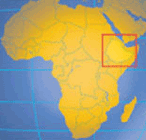|
|
|
|
|
|
A pleasant surprise occurred on day 3 of our Historic Route journey through Ethiopia. Following a short flight on Ethiopian Airlines from Gondar to Bahir Dar Airport, the gut-wrenching condition of the road leading west led me to believe our group of 11 journalists would be staying at some dusty lakeside village. However, like several of my colleagues, I was completely bowled over when tall palms and jacarandas suddenly appeared out of the blue. Like part of a royal procession, we entered a modern, well laid out community with broad, tree-lined boulevards. Bahir Dar would rival many seaside retreats on the Mediterranean or Florida.
Nature's
Brush, Fields of Gold and Smoke of
Fire The Ahramic name for the Blue Nile Falls is 'Tissisat' or 'smoke of fire' &emdash; which describes what many claim to be the most spectacular waterfalls in Northern Africa. Here a wide body of water drops over a sheer cliff more than 45 meters deep. In many photos I have seen, that curtain of spray kissed by a brilliant rainbow. Speaking of rainbows and pots of gold &emdash; in September I'm told it's a sure sign of spring, when the 'Meskel" flower turns entire hills and fields to gold. Our Grand Tour Edition will feature Ethiopia's Southern regions, and we will follow the tracks of Ethiopia's railway, from Addis Ababa to Djibouti on the Gulf of Aden . |




 En
route to Lake Tana, I spotted a huge resort hotel complex
nearing completion &emdash; a sign of positive things to
come. After checking into our hotel, we boarded a motor
launch for a spin around Lake Tana, which is Ethiopia's
largest lake. We're told there are 37 small islands on the
lake, and most of them shelter monasteries and churches,
some dating back to the 13th century. On most inland bodies
of water of this size, one might encounter powerboats and
sleek sailing craft, but on Lake Tana in Northern Ethiopia,
leisure gives way to practicality. Here, the waters are
alive with a fleet of 'tankwas' , papyrus canoes, carrying
charcoal and firewood to market in Bahir Dar.
En
route to Lake Tana, I spotted a huge resort hotel complex
nearing completion &emdash; a sign of positive things to
come. After checking into our hotel, we boarded a motor
launch for a spin around Lake Tana, which is Ethiopia's
largest lake. We're told there are 37 small islands on the
lake, and most of them shelter monasteries and churches,
some dating back to the 13th century. On most inland bodies
of water of this size, one might encounter powerboats and
sleek sailing craft, but on Lake Tana in Northern Ethiopia,
leisure gives way to practicality. Here, the waters are
alive with a fleet of 'tankwas' , papyrus canoes, carrying
charcoal and firewood to market in Bahir Dar. 